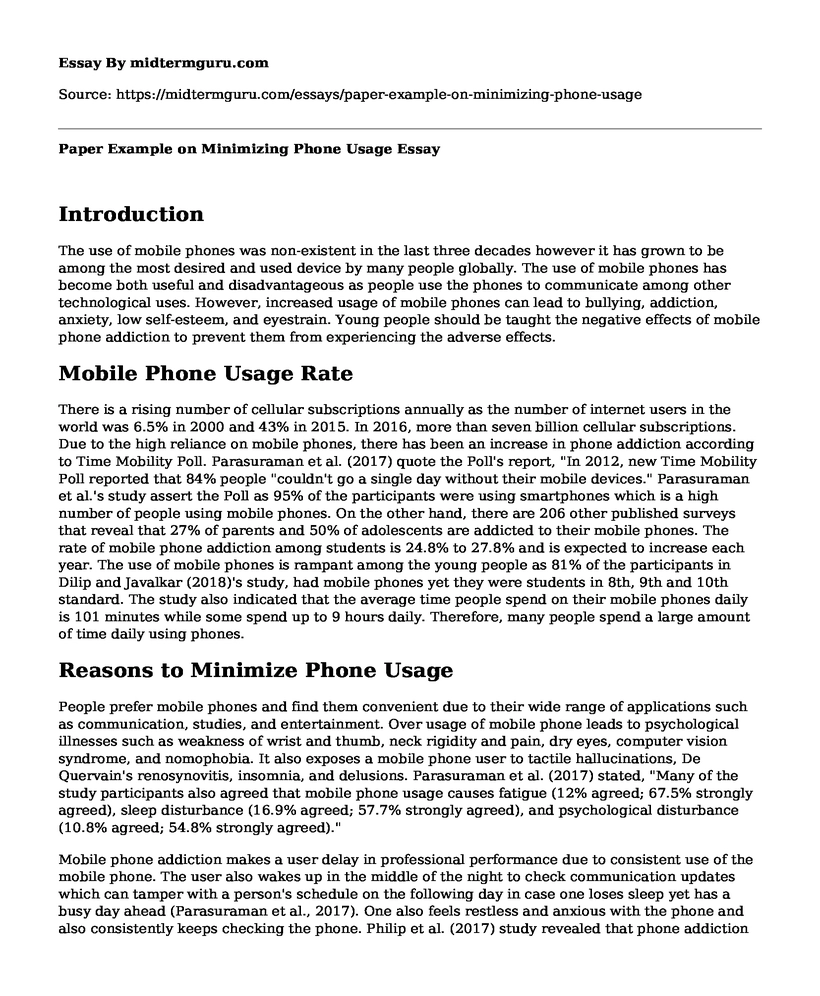Introduction
The use of mobile phones was non-existent in the last three decades however it has grown to be among the most desired and used device by many people globally. The use of mobile phones has become both useful and disadvantageous as people use the phones to communicate among other technological uses. However, increased usage of mobile phones can lead to bullying, addiction, anxiety, low self-esteem, and eyestrain. Young people should be taught the negative effects of mobile phone addiction to prevent them from experiencing the adverse effects.
Mobile Phone Usage Rate
There is a rising number of cellular subscriptions annually as the number of internet users in the world was 6.5% in 2000 and 43% in 2015. In 2016, more than seven billion cellular subscriptions. Due to the high reliance on mobile phones, there has been an increase in phone addiction according to Time Mobility Poll. Parasuraman et al. (2017) quote the Poll's report, "In 2012, new Time Mobility Poll reported that 84% people "couldn't go a single day without their mobile devices." Parasuraman et al.'s study assert the Poll as 95% of the participants were using smartphones which is a high number of people using mobile phones. On the other hand, there are 206 other published surveys that reveal that 27% of parents and 50% of adolescents are addicted to their mobile phones. The rate of mobile phone addiction among students is 24.8% to 27.8% and is expected to increase each year. The use of mobile phones is rampant among the young people as 81% of the participants in Dilip and Javalkar (2018)'s study, had mobile phones yet they were students in 8th, 9th and 10th standard. The study also indicated that the average time people spend on their mobile phones daily is 101 minutes while some spend up to 9 hours daily. Therefore, many people spend a large amount of time daily using phones.
Reasons to Minimize Phone Usage
People prefer mobile phones and find them convenient due to their wide range of applications such as communication, studies, and entertainment. Over usage of mobile phone leads to psychological illnesses such as weakness of wrist and thumb, neck rigidity and pain, dry eyes, computer vision syndrome, and nomophobia. It also exposes a mobile phone user to tactile hallucinations, De Quervain's renosynovitis, insomnia, and delusions. Parasuraman et al. (2017) stated, "Many of the study participants also agreed that mobile phone usage causes fatigue (12% agreed; 67.5% strongly agreed), sleep disturbance (16.9% agreed; 57.7% strongly agreed), and psychological disturbance (10.8% agreed; 54.8% strongly agreed)."
Mobile phone addiction makes a user delay in professional performance due to consistent use of the mobile phone. The user also wakes up in the middle of the night to check communication updates which can tamper with a person's schedule on the following day in case one loses sleep yet has a busy day ahead (Parasuraman et al., 2017). One also feels restless and anxious with the phone and also consistently keeps checking the phone. Philip et al. (2017) study revealed that phone addiction leads to hearing loss and tinnitus due to exposure to ionizing and nonionizing radiation. Electromagnetic radiation (EMR) from the mobile phones can lead to ear discomfort, De Quervain's syndrome as well as pain on the wrist.
Reducing Phone Usage
Dilip et al. (2017) state, "phones. Current need of the hour is the awareness regarding this dependency behavior and appropriate information, education, and interventions." The authors also state that it is important to monitor the growing trends of mobile phone usage in early stages to prevent their negative outcomes. Philip et al. (2017) suggest that young people need to be educated about the negative effects of prolonged mobile phone usage to prevent negative impacts on their lives.
Conclusion
Mobile phones are widely used in today's society however they have many negative effects. Young people should learn about its adverse effects to prevent effects such as neck rigidity, poor performance, and sleep disturbance.
References
Dilip, B., & Javalkar, S. R. (2018). Mobile phone usage pattern and dependency among school going adolescents in Davanagere, Karnataka. Medica, 7(1), 35.
Parasuraman, S., Sam, A. T., Yee, S. W. K., Chuon, B. L. C., & Ren, L. Y. (2017). Smartphone usage and increased risk of mobile phone addiction: A concurrent study. International journal of pharmaceutical investigation, 7(3), 125.
Philip, P., Bhandary, S. K., Aroor, R., Bhat, V., & Pratap, D. (2017). The effect of mobile phone usage on hearing in adult population. Indian Journal of Otology, 23(1), 1.
Cite this page
Paper Example on Minimizing Phone Usage. (2022, Sep 25). Retrieved from https://midtermguru.com/essays/paper-example-on-minimizing-phone-usage
If you are the original author of this essay and no longer wish to have it published on the midtermguru.com website, please click below to request its removal:
- Significance of Drones in Disaster Management and Commerce
- Paper Example on Minimizing Phone Usage
- Research Paper on Use of Surveillance Drones for Virtual City
- Essay Sample on Adoption of Solar Power in Mali
- The Nature of Enron's Business - Essay Sample
- Essay Sample on Epic System in Medicine
- Smartphone Revolution: A 2011 Primary School Story - Essay Sample







